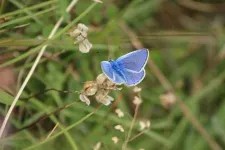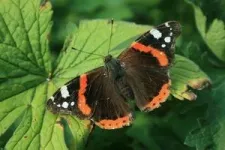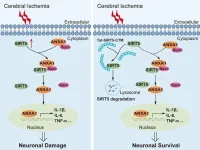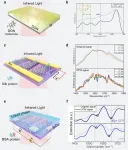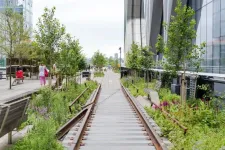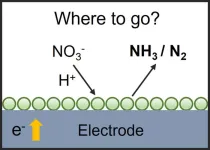(Press-News.org) Butterfly populations in Catalonia in northern Spain are better than their UK counterparts at regulating their body temperature by basking in the sunshine, but rising global temperatures due to climate change may put Spanish butterflies at greater risk of extinction.
An international study, led by the University of Cambridge and the Institut de Biologia Evolutiva (IBE) in Barcelona, found that butterflies use different methods to regulate their body temperature. In Catalonia, butterflies tend to angle their wings towards the sun to warm up at lower temperatures, while British butterflies rely more on finding warm microclimates.
However, as temperatures rise, both populations switch to heat-avoiding behaviour. As global temperatures rise, British butterflies may initially benefit, while Spanish butterflies may not be able to survive if they are not able to adapt quickly enough.
However, habitat loss, particularly in the UK, is an equally important threat to butterflies. Diverse habitats offer butterflies a greater variety of microclimates, and initiatives such as ‘no-mow May’, allowing wildflowers to grow along roadsides, and planting more trees can help counter habitat loss. The results are reported in the Journal of Animal Ecology.
Like all insects, butterflies are ‘cold-blooded’ and use their environment to regulate their internal temperature. Understanding how butterflies thermoregulate is important for predicting which species are most at risk from the effects of climate change.
In a study published in 2020, several of the same researchers showed that there are significant variations in the ability of different UK butterfly species to maintain a suitable body temperature. Species that rely mostly on shade to keep cool are at greatest risk of population decline, due to climate change and habitat loss.
“The first study in the UK showed that butterflies are pretty good at regulating their body temperature in this cooler climate, but we wanted to see whether butterflies in a warmer climate, such as Spain, are doing anything differently,” said lead author Eric Toro-Delgado from IBE, a joint centre of the Consejo Superior de Investigaciones Científicas (CSIC) and Universitat Pompeu Fabra (UPF), “And if there are differences, what mechanisms might be driving it?”
“In Spain, butterflies spend much more time at their optimum temperature since it’s warmer, but there’s also a greater risk of overheating,” said Dr Andrew Bladon from Cambridge’s Department of Zoology, the study’s senior author. “We wanted to see whether the results we got from our UK data would be repeatable in a different environment.”
For the current study, the researchers collected similar data as the 2020 UK paper, but from butterflies in Catalonia. They measured body temperature, air temperature, and perch temperature for almost 800 adult butterflies from 23 different species: for ten of these species, the researchers had comparable data from the UK.
“We hypothesised that Spanish butterflies might show adaptations to their warmer climate, which could give us an indication of how British butterflies might need to adapt to cope with climate change,” said Bladon.
The researchers found that on a community level, butterflies in Catalonia were better at regulating, or buffering, their body temperature than British butterflies. Butterflies in both countries switch from heat-seeking to heat-avoiding behaviour once air temperatures reach approximately 22°C. However, the communities differ in the use of buffering mechanisms, with British populations depending more on microclimates for thermoregulation compared to Catalan populations.
Many landscapes in the UK do not provide a sufficient diversity of thermal environments, with alternating areas of shade and sun. For UK butterflies that rely on microclimates to regulate body temperature, habitat and biodiversity loss is a major threat. In Catalonia, one of the reasons why butterflies are better at regulating their temperature could be because butterflies have many more thermal options available to them.
“In the UK, many of our nature reserves are like islands, with little variety in between,” said Bladon. “If we can provide them with field margins, biodiverse road verges, more wildflowers, and longer grass, butterflies can more easily move through the landscape, helping them find their preferred temperatures so they can thrive.”
Although Catalan butterfly populations seem to be able to thermoregulate successfully at present, rising global temperatures due to climate change put them at greater risk, since it is so warm in Spain already.
“In the UK study, the Cambridge team found that wing size was related to the ability of a species to regulate its body temperature, and that species with large wings were better at it,” said Toro-Delgado. “We expected to find a similar result in Spain, but we didn’t. This is likely because in a warm country like Spain, the ability to avoid heat is preferable, and wings may play a less relevant role in this than in warming up.”
“Because of rising global temperatures, the UK’s climate is becoming a little bit more like Spain, so climate change may benefit British butterflies in the short term,” said Bladon. “But what’s striking is butterflies in both countries showed signs of heat avoidance. And the Catalan butterflies are at greater risk since they are already near their thermal optimum.”
The researchers say that beyond rising temperatures, butterflies are also at risk from associated climate impacts, such as droughts or heatwaves. These extreme weather events can not only push butterflies past their thermal limits, but it can kill the plants which their caterpillars rely on.
“Climate change is a two-pronged attack that can take out both adult butterflies and their caterpillars,” said Toro-Delgado. “Climate change and biodiversity loss go hand-in-hand, and we urgently need to address both if we’re going to protect important species like butterflies.”
The research was supported in part by the Spanish National Research Council, the Isaac Newton Trust, Wellcome, Generalitat de Catalunya, the Spanish Ministry of Science, Innovation and Universities, the UK Natural Environment Research Council, and the European Social Fund Plus.
END
Spanish butterflies better at regulating their body temperature than their British cousins
2024-01-09
ELSE PRESS RELEASES FROM THIS DATE:
A novel cell-penetrating peptide exerts therapeutic effects against ischemic stroke
2024-01-09
This study is led by Dr. Xing Li and Dr. Yilin Zhao (Department of Anesthesiology, Hubei Key Laboratory of Geriatric Anesthesia and Perioperative Brain Health, and Wuhan Clinical Research Center for Geriatric Anesthesia, Tongji Hospital, Tongji Medical College, Huazhong University of Science and Technology). The team's previous research found that the increase in SIRT5 in microglia induced by ischemic stroke causes annexin-A1 (ANXA1) desuccinylation, which decreases ANXA1 membrane recruitment and secretion but promotes ANXA1 nuclear translocation, resulting in the production of proinflammatory ...
Ultrasensitive molecular sensing with synthesize complex-frequencey waves
2024-01-09
Sensors are essential tools for detecting and analyzing trace molecules in a variety of fields, including environmental monitoring, food safety, and public health. However, developing sensors with high enough sensitivity to detect these tiny amounts of molecules remains a challenge.
One promising approach is surface-enhanced infrared absorption (SEIRA), which uses plasmonic nanostructures to amplify the infrared signals of molecules adsorbed on their surface. Graphene is a particularly promising material for SEIRA because of its high ...
Creating novel amino acid nanoparticles with enhanced anticancer activity
2024-01-09
Ishikawa, Japan -- Amino acids, such as tyrosine and tryptophan, are the fundamental building blocks that make up proteins. These biomolecules have different chemical groups on each end and side chain, and so, have the natural ability to form a chain through the formation of an amide (peptide) bond. However, such linkages are weak and easily degraded under physiological conditions. This is where the Fmoc-protected amino acids come into the picture.
In a new study now, a research team led by Dr. Eijiro Miyako, Associate ...
A landscape-based approach to urban heritage management: People, spatial biography, and ecosystem
2024-01-09
This article first identifies the current definition of urban heritage that includes both “old” and “young” monuments. Their protection has also shifted from solely preserving “old” values into a more holistic process to retain “old” values and manage the change in their adaptive reuse to gain “new” values, towards a more people-centered and landscape-based approach. Furthermore, a concept of ecosystem for urban planning and development is introduced, ...
Photostimulation: non-invasive and effective therapeutic approach for Alzheimer’s disease
2024-01-09
Alzheimer’s disease (AD) is an age-related neurodegenerative disorder. β-amyloid (Aβ) deposition in the brain is a crucial contributor to the pathogenesis of AD, mitigating excessive cerebral Aβ burden has been considered as a possible therapeutic strategy for AD. Meningeal lymphatic vessels (MLVs) are recently discovered structures responsible for exchanging soluble components between the cerebrospinal fluid and interstitial fluid, and have been proved to be a potential pathway of Aβ drainage.
Researchers at Huazhong University ...
Love scrambles the brain and scientists can now tell us why
2024-01-09
Love is blind, the saying goes, and thanks to a world-first Australian study, we are now a step closer to understanding why.
It is well known that romantic love changes the brain, releasing the so-called love hormone oxytocin, responsible for the euphoria we feel when falling in love.
Now, researchers from the ANU, University of Canberra and University of South Australia have measured how a part of the brain is responsible for putting our loved one on a pedestal in that first flush of romance.
In the world’s first study investigating the link between the human brain’s behavioural activation ...
Where to go with nitrate electroreduction reaction?
2024-01-09
Ammonia is a necessary feedstock to produce nitrogen-based fertilizers, chemicals, pharmaceuticals, and polymers. To date, about 80% of global ammonia is used to produce nitrogen-based fertilizers which relates to 50% of global food production. The global production of ammonia is about 180 million metric tons per year through the carbon-intensive and highly energy-consuming Haber-Bosch process. The high energy consumption, high carbon intensity, and high capital investment of the Haber-Bosch process make the development of environmentally sustainable and affordable routes for ammonia synthesis under ambient conditions more urgent. The electrochemical ammonia ...
Measuring grass pollen allergens instead of grass pollen count will help hay fever sufferers
2024-01-09
Measuring airborne grass allergen levels instead of pollen counts will be more beneficial for hay fever sufferers as new research shows grass allergen levels are more consistently associated with hay fever symptoms than grass pollen counts.
The research, published today in The Journal of Allergy and Clinical Immunology and led by King’s College London and Imperial College London, shows for the first time that measuring airborne allergen levels will help people with hay fever better control their symptoms.
1 in 4 adults in the UK suffer from hay fever from late-March to September. Symptoms include a runny or blocked ...
Clear link between autoimmune disease and perinatal depression
2024-01-09
Women with autoimmune disease are more likely to suffer from depression during pregnancy and after childbirth; conversely, women with a history of perinatal depression are at higher risk of developing autoimmune disease, a new study from Karolinska Institutet published in the journal Molecular Psychiatry reports.
In autoimmune disease, the immune system mistakenly attacks the body’s own healthy tissue. Some of the most common autoimmune diseases are gluten intolerance (coeliac disease), autoimmune thyroiditis, rheumatoid ...
Diagnostic errors are common in seriously ill hospitalized adults
2024-01-09
A study of seriously ill patients from academic medical centers across the country has found that nearly a quarter had a delayed or missed diagnosis.
All the patients had either been transferred to the intensive care unit (ICU) after being admitted or died in the hospital. The researchers concluded that three-quarters of these diagnostic errors contributed to temporary or permanent harm, and that diagnostic errors played a role in about one in 15 of the deaths.
The most common errors identified in the study involved delayed rather than missed diagnoses, for example because a specialist was consulted too late or an alternate diagnosis was not considered ...
